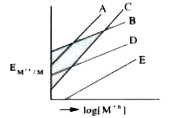An aqueous solution containing one mole per litre of each Cu(NO3)2,AgNO3.Hg(NO3)2,Mg(NO3)2 is being electrolysed using inert electrodes. The values of standard electrode potential (reduction potential) in volts are
Ag/Ag+=+0.80V Hg/Hg2+=+0.79V Cu/Cu2+=+0.34V Mg/Mg2+=−2.37V
With increasing voltage, the sequence of deposition of metals on cathode will be Solution in Telugu
Ag , Hg , Cu ,Mg
Mg , Cu , Hg , Ag
Ag,Hg,Cu,H2
Cu,Hg,Ag
The correct Answer is:C
Ag/Ag+=0.80V,Hg/Hg+=0.79V,Cu/Cu+2=0.34V,Mg/Mg+2=2.37V
Higher reaction potential , Metal deposits more at cathode
Topper's Solved these Questions
- BOOK - AAKASH SERIESCHAPTER - ELECTROCHEMISTRY EXERCISE - PRACTICE SHEET -5 (LINKED COMPREHENSION TYPE QUESTIONS (PASSAGE-I))3videos
ELECTROCHEMISTRY
- BOOK - AAKASH SERIESCHAPTER - ELECTROCHEMISTRY EXERCISE - PRACTICE SHEET -5 (LINKED COMPREHENSION TYPE QUESTIONS (PASSAGE-II))3videos
ELECTROCHEMISTRY
- BOOK - AAKASH SERIESCHAPTER - ELECTROCHEMISTRY EXERCISE - PRACTICE SHEET -4 (INTEGER ANSWER TYPE QUESTIONS )6videos
ELECTROCHEMISTRY
- BOOK - AAKASH SERIESCHAPTER - DILUTE SOLUTIONSEXERCISE - EXERCISE - 1.255videos
DILUTE SOLUTIONS
- BOOK - AAKASH SERIESCHAPTER - ELEMENTS OF D - BLOCKEXERCISE - EXERCISE - 5.233videos
ELEMENTS OF D - BLOCK
Similar Questions
Nernst equation gives the variation of potential of an electrode based on activity of ions temperature and pressure. The equation is
E=E∘−2.303RTnFlogQ(or)E=E∘−0.0591nlogQ
E∘= Standard potential and 'Q' is the reaction quotient.
What is the reduction potential of a hydrogen electrode in an aqueous solution containing 0.1 M NH4OH,(Kb=10−5), ?02:47View SolutionFor metal electrodes show the variation in their reduction potential as shown.

Which is the most reactive metal ?02:47View SolutionDuring electrolysis of one mole or aq HCOOK . How many moles of H2 is formed overall ?
03:29View SolutionWhat are the factor on-which solubility depends on ?
02:47View SolutionGive some examples for the ions with pseudo inert gas electronic configuration.
03:29View SolutionA solution containing 1 mol per litre of each Cu(NO_(3))_(2), AgNO_(3), and Hg_(2)(NO_(3))_(2) is being electrolyzed by using inert electrodes. The values of standard electrode potentials in volts ( reduction potential ) are Ag|Ag^(o+)=+0.80, 2Hg|Hg_(2)^(2+)=+0.79 Cu|Cu^(2+)=+0.34,Mg|Mg^(2+)=-2.37 . With increasing voltage, the sequence of deposition of metals at the cathode will be
02:47View SolutionA solution containing one mole per litre of each Cu(NO3)2,AgNO3,Hg2(NO3)2 is being electrolysed by using inert electrodes. The values of standard electrode potentials in volts (reduction potentials) are
Ag+/Ag=+0.80V,HG2+2/Hg=+0.79V
Cu+/Cu=+0.34V,Mg2+/Mg=−2.37V
With increasing valtage, the sequence of deposition of metals on the cathode will beView SolutionAn aqueous solution containing one mole per litre of each Cu(NO3)2,AgNO3,Hg(NO3)2 is being electrolysed using inert electrodes. The values of standard electrdoe potential in volts (reduction potential) are
Ag∣∣Ag+=+0.802Hg∣∣Hg2+=+0.79
Cu∣∣Cu2+=+0.34Mg∣∣Mg2+=−2.37
With increasing voltage, the sequence of deposition of metals on cathode will beView SolutionA solution containing 1mol per litre of each Cu(NO3)2,AgNO3, andHg2(NO3)2 is being electrolyzed by using inert electrodes. The values of standard electrode potentials in volts ( reduction potential ) are
Ag∣∣Ag⊕=+0.80,2Hg∣∣Hg2+2=+0.79
Cu∣∣Cu2+=+0.34,Mg∣∣Mg2+=−2.37.
With increasing voltage, the sequence of deposition of metals at the cathode will beView SolutionAn aqueous solution containing one mole per litre of each Cu(NO_(3))_(2),AgNO_(3),Hg_(2)(NO_(3))_(2) and Mg(NO_(3))_(2) is being electrolysed using inert electrodes. The values of the standard electrode potentials in volts (reduction potentials) are Ag|Ag^(+)=0.80,2Hg|Hg_(2)^(2+)=+0.79 Cu|Cu^(2+)=+0.34,Mg|Mg^(2+)=-2.37 With increasing voltage, the sequence of deposition of metals on cathode will be
02:42View SolutionA solution containing one mole per litre of each Cu(NO3)2,AgNO3,Hg2(NO3)2 is being electrolysed by using inert electrodes. The values of standard electrode potentials in volts (reduction potentials) are
Ag+/Ag=+0.80V,HG2+2/Hg=+0.79V
Cu+/Cu=+0.34V,Mg2+/Mg=−2.37V
With increasing valtage, the sequence of deposition of metals on the cathode will be02:17View SolutionA solution containing one mole per litre each of Cu(NO3)2,AgNO3,Hg2(NO3)2,Mg(NO3)2 is being electrolyesd by using inert electrodes. The value of standard reduction potentials are Ag+/Ag=+0.80V,Hg2+2/Hg=0.79V,Cu2+/Cu=+0.34V,Mg2+/Mg=−2.7V. with increasing voltage, the sequence of deposition of metals on the cathode will be:
02:17View SolutionAn aqueous solution containing one mole per litre of Cu(NO3)2,AgNO3,Hg(NO3)2 and Mg(NO3)2 is being electrolysed using inert electrodes. The values of the standard electrode potentials in volts (reduction potientials) are
Ag∣∣Ag+=+0.80,2Hg∣∣Hg2+=0.79
Cu∣∣Cu2+=+0.34,Mg∣∣Mg2+=−2.37
With increasing voltage, the sequence of deposition of metals on cathode will be01:55View SolutionGiven that the standard electrode potentials (E∘) of metals are:
K+/K=−2.93V,Ag+/Ag=0.80V,Cu2+/Cu=0.34V,Mg2+/Mg=−2.37V,Cr3+/Cr=−0.74V,Fe2+/Fe=−0.44V.
Arrange these metals in an increasing order of their reducing power.01:55View SolutionWhich is increasing order of the reducing power of the following metals on the basis of standard electrode potential ? Ag^(+)//Ag=0.80 V " "Mg^(2+)//Mg=-2.37V Hg^(2+)//Hg=0.79V" "Cr^(3+)//Cr=-0.74V
02:54View SolutionAn aqueous solution containing one mole per litre of each Cu(NO3)2,AgNO3.Hg(NO3)2,Mg(NO3)2 is being electrolysed using inert electrodes. The values of standard electrode potential (reduction potential) in volts are
Ag/Ag+=+0.80V Hg/Hg2+=+0.79V Cu/Cu2+=+0.34V Mg/Mg2+=−2.37V
With increasing voltage, the sequence of deposition of metals on cathode will be01:45View Solution

